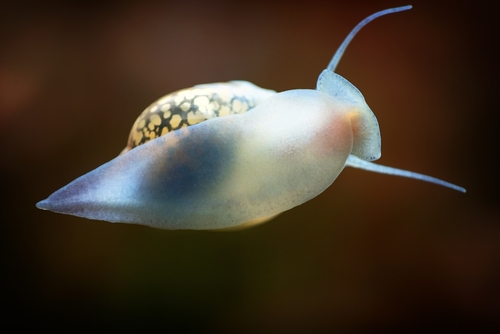Bladder snails, scientifically known as Physella acuta, are often the unsung heroes of the aquarium world. These small, unassuming creatures, part of the Physidae family, are typically considered more of a nuisance than a benefit.
However, if you look a little closer, you’ll find these tiny gastropods have much to offer.
With their thin, transparent shells that come in various colours – from earthy browns and yellows to unique shades of olive green – bladder snails add a touch of subtle beauty to any aquarium.
But their appeal goes beyond just their looks. These fascinating creatures are air-breathers, often seen swimming upside down at the water’s surface as they fill their lungs with air. This unique behaviour makes them interesting to watch and contributes to your aquarium’s overall health.
Despite their reputation as invasive pests, bladder snails are excellent cleaners. They help maintain a clean and healthy environment by consuming excess food, decaying plants, and even algae.
Plus, their ability to adapt to a wide range of environments, including polluted waters, makes them hardy additions to any tank.
So, the next time you spot a bladder snail in your aquarium, remember: they’re not just uninvited guests. They’re hardworking, beneficial creatures crucial in keeping your aquarium clean and healthy.
Want to learn more about bladder snails? Keep reading for all you need to know, starting with some key points.
Contents
Key Takeaways
- Bladder snails are often considered invasive species and pests in aquariums.
- These snails have thin, transparent shells and are air-breathing creatures.
- Their adaptability sparks debates within the aquarium community.
Don’t miss out on these other popular posts:
Appearance and Identification

1. Shell Structure and Size
Bladder snails have a small, cone-shaped shell, with the largest specimens reaching a size of about 0.6 inches (1.5 cm) in diameter and 2 inches (5 cm) in length.
Their shells are thin and oval, making them appear delicate compared to other snail species. The compactness of their shells aids in their survival, as they can effectively manoeuvre within their aquatic environment.
2. Sinistral Shell
A fascinating trait that sets bladder snails apart from other snails is the sinistral shell; their shells spiral to the left.
While most snail species have shells that spiral to the right or dextral, bladder snails are unique in their counterclockwise coiling. This feature can be essential for identification, distinguishing them from other snail species in your aquarium.
3. Colour and Pattern
The colour and pattern of bladder snails vary, with their thin and translucent shells primarily being pale yellow. On closer inspection, you may notice gold-coloured spots and markings, giving them a distinct appearance.
Their translucent shells allow you to see their skin, which often has a grey base colour, sometimes adorned with purple or black splashes.
In addition to their unique shell structure, bladder snails possess tentacles and eyes that aid them in their daily activities. These small creatures confidently navigate their surroundings and showcase a remarkable ability to adapt to various aquatic environments.
Taxonomy and Distribution
Classification and Subspecies
The bladder snail of the Physidae family and Gastropoda class. Common names include European physa, tadpole snail, and acute bladder snail.
Physella acuta was previously referred to as Physa acuta and Physella heterostropha, but these names have been synonymised with the current designation.
The Physidae family of snails is often referred to as the bladder snails, pouch snails, or tadpole snails, and they are part of the superfamily Lymnaeoidea. Their presence in ponds, aquariums, and the wild makes them quite widespread and easy to identify.
Zoogeography
Bladder snails have a wide distribution across the globe. As the name European physa suggests, they were once considered native to Europe and introduced to North America.
However, it is now known that they are present in other continents as well, such as Africa, Asia, and North America. Bladder snails are considered invasive species in some regions due to their rapid reproduction and adaptability.
They thrive in various freshwater habitats, including ponds, rivers, streams, and lakes. They adapt quickly to different environmental conditions and can tolerate a wide range of water temperatures and pollutant levels.
While they are often considered pests, bladder snails play a significant role in maintaining ecosystem balance by consuming algae, detritus, and dead plant matter. The availability of food and space regulates their populations.
Habitat and Ecology

Natural Settings
Bladder snails (Physella acuta) are found in various freshwater habitats, including rivers, lakes, and streams. Due to their ability to breathe air via a lung, they are often seen near the water surface where they can access oxygen.
These snails are common in the North Temperate to Arctic Zones and throughout the Americas. They can also be found in Asia, Africa, Australia, Europe, and North America, occurring on all continents except Antarctica.
The bladder snail tolerates various water conditions, including varying temperatures and pH levels. They live in areas with diverse vegetation, often found among aquatic plants and algae. In their natural habitats, bladder snails are essential in breaking down organic matter and promoting overall ecosystem health.
Man-Made Environments
Bladder snails are highly adaptable and can thrive in artificial environments such as ponds, ditches, rice fields, irrigation canals, and municipality drains. This adaptability, coupled with their prolific breeding abilities, has led to some areas considering them an invasive species.
Despite this, they can still contribute to the healthy functioning of these environments by helping to break down decaying plant matter and reducing the buildup of pollutants.
Behaviour and Diet
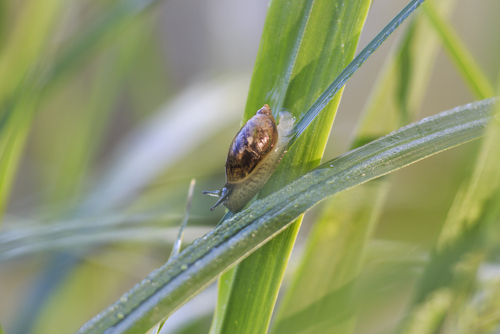
Movement and Swimming
Bladder snails are known for their unique movement in the water. They can both crawl on surfaces and swim through the water column. When crawling, they use their muscular foot to glide over surfaces such as rocks, plants, and glass.
To swim, bladder snails create a wave-like motion with their foot, allowing them to move through the water efficiently. They are primarily active at night, showing nocturnal behaviour as they search for food in dark underwater habitats.
Feeding Habits
As omnivores, bladder snails have a diverse diet. Their food preferences include algae, dead plant material, and detritus. They act as natural algae eaters, helping to keep the aquarium clean and balanced.
Besides plant-based matter, bladder snails also consume animal-based food sources. They are known to feed on small invertebrates, such as daphnia, and fish eggs.
Calcium plays a critical role in a bladder snail’s diet. Adequate calcium intake is essential for the development and maintenance of their shells. Aquarists can provide additional sources of calcium through supplements, cuttlebone, or by adding crushed eggshells to the tank.
Aquarium Care
Water Parameters
When it comes to caring for bladder snails, maintaining the proper water parameters is essential. These small snails thrive in a freshwater tank environment with a pH range of 7-8.
Although they can tolerate a wider range of water conditions, including acidic and deoxygenated water, keeping the water clean and stable for optimal health is recommended.
Regular monitoring of nitrate levels is also important, as high nitrate concentrations can harm bladder snails. Additionally, avoid using copper-based treatments in your tank since copper is toxic to snails.
Food and Diet
Bladder snails are active waste and algae eaters that contribute to the overall cleanliness of your aquarium. Their regular diet primarily consists of algae and decaying plants. However, they can also consume leftover fish food, which helps in keeping the tank clean.
To supplement their diet and ensure their health, you can provide them with blanched vegetables like spinach or zucchini. Be sure to remove any uneaten food to maintain proper water quality.
Tank Conditions

Providing the right tank conditions is an important aspect of bladder snail care. While they can survive in various environments, bladder snails typically prefer temperatures between 64-84 degrees Fahrenheit. As for tank size, these small snails don’t require much space, but sufficient room should be provided to avoid overcrowding.
A well-planted tank with hiding spots, such as driftwood or rocks, will make the snails feel secure and help prevent stress. By considering these factors and maintaining suitable water parameters, food sources, and tank conditions, you can ensure a healthy environment for your bladder snails.
Breeding and Reproduction
Hermaphroditic Nature
Bladder snails are unique due to their hermaphroditic nature, meaning they possess both male and female reproductive organs. This allows them to reproduce both sexually and asexually. As a result, these snails can self-fertilize.
They can also reproduce with another bladder snail, making them prolific breeders capable of rapidly multiplying quickly.
Brooding and Laying
To maintain their population, bladder snails prefer laying their eggs in areas with abundant food sources and suitable surfaces. They often lay translucent, gelatinous egg masses on aquatic plants, solid aquarium surfaces, or submerged decorations within the tank.
Each egg mass contains multiple eggs, which eventually hatch into baby bladder snails. The entire process of brooding and laying takes approximately one week, allowing the species to spawn a new generation of snails quickly.
Baby Bladder Snails
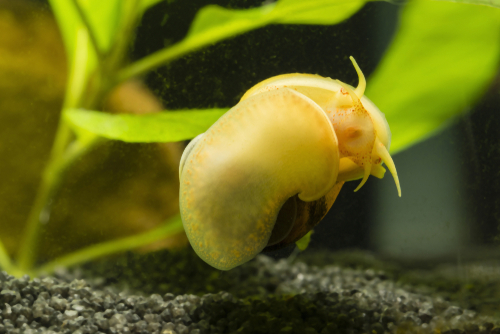
Once the eggs hatch, the baby bladder snails emerge, already equipped with tiny shells and ready to start exploring their environment. In the initial stages of their lives, the baby snails feed on microscopic algae and other organic matter to sustain their growth.
As their size and appetite increase, they gradually switch to feeding on detritus, uneaten food, decomposing plant matter, and even smaller snails.
The lifespan of a bladder snail typically spans around 3 to 6 months, during which time they continue to breed, contributing to the overall population within the aquarium.
Tank Mates and Compatibility
Bladder snails are generally peaceful and can coexist with various tank mates. However, care should be taken to avoid certain combinations that can endanger the bladder snail population in your tank.
Best Tank Mates
Bladder snails have a non-aggressive temperament and are compatible with a wide range of equally peaceful tank mates. These can include small and non-aggressive fish like tetras, guppies, and livebearers.
Moreover, they can also be housed with other types of snails (except assassin snails) and various shrimp species, such as cherry shrimp and amano shrimp. Combined with their tank-cleaning abilities, bladder snails make a great addition to freshwater community tanks.
Unsafe Combinations
Keeping bladder snails with known predators or aggressive species is not recommended. In particular, avoid species such as pufferfish and crayfish, known to prey on snails.
Additionally, prevent bladder housing snails with assassin snails, which are natural adversaries and can potentially wipe out an entire bladder snail population.
Be cautious when selecting suitable tank mates, ensuring they have a similar temperament and coexist peacefully with bladder snails.
Comparison to Other Snail Species

Bladder Snail vs Pond Snail
Bladder snails and pond snails are two different freshwater snail species that are often compared due to their similar habitat preferences and appearance.
The most noticeable difference between the two lies in their shell shape. Bladder snails have a more elongated, conical shell with a pointed, acute apex, while pond snails boast a rounded, more voluminous shell.
Another important distinction is their reproduction habits. Pond snails are known to be prolific breeders, laying up to 100 eggs at a time, whereas bladder snails generally only lay around 20-30 eggs. Both species, however, can reproduce rapidly, making their populations difficult to control.
In their natural habitats, pond snails and bladder snails play essential roles as decomposers, feeding on algae, dead plants, and other detritus in the water. Their presence can help maintain the water quality in their aquatic environments.
Bladder Snail vs Planorbidae
Bladder snails (Physidae family) and Planorbidae snails are two other freshwater snail species that share some similarities yet possess unique traits that set them apart.
One significant difference between the two is the presence of an operculum – a protective plate covering the shell’s opening. Bladder snails, unlike Planorbidae snails, do not have an operculum.
Planorbidae snails are commonly known as ramshorn snails due to their circular, flat-coiled shells resembling the horns of a ram. In contrast, bladder snails have more conical, non-flat shells.
Both families of snails play a similar role in aquatic ecosystems, feeding on algae and dead plant material.
The Planorbidae and Physidae families have unique aspects in their anatomy as well. Bladder snails have a so-called “mantle”, a fleshy part of their bodies that extends over the shell edge. Planorbidae snails, however, do not exhibit this feature.
Role in the Ecosystem and Human Interaction
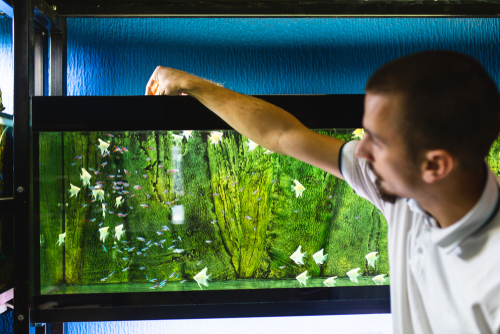
Bladder snails play a significant role in freshwater ecosystems. They are often found in ponds, rivers, and lakes. These snails are highly adaptable, which has led to their presence on multiple continents. In their natural environments, they feed on detritus, algae, and dead plants, contributing to the overall health and balance of the ecosystem.
Protection and Control
As highly adaptable organisms, bladder snails can sometimes become invasive, causing imbalances in the ecosystem. One notable example is the acute bladder snail, Physella acuta, which is considered an invasive species due to its rapid reproduction rate.
Local authorities and environmentalists need to keep these snail populations under control to prevent ecological damage.
Aquarium Trade and Use
Bladder snails are popular in the aquarium trade due to their ability to serve as natural aquarium cleaners. They help remove debris and maintain water quality, promoting the aquarium inhabitants’ overall health.
Hobbyists often introduce these snails into their tanks to reduce the need for manual cleaning and chemical additives. However, it’s essential to consider the potential risks and ecological impact that arise from introducing these snails to different environments to ensure responsible practices within the aquarium trade.
Frequently Asked Questions
Are bladder snails bad for your tank?
Although bladder snails are often considered pests by aquarium enthusiasts, they aren’t necessarily harmful. These small molluscs help keep your tank clean by consuming algae and dead plant matter. However, they can overpopulate a tank if left unchecked and are considered an invasive species.
Should I remove bladder snails?
Bladder snails can be a nuisance, especially if their population gets out of hand. While removing some bladder snails can help control their numbers, it’s important to address the underlying issue, such as overfeeding or an abundance of organic matter in the tank.
How did bladder snails get in my tank?
Bladder snails commonly hitchhike into aquariums by being accidentally introduced through plants, decorations, or even on the shells of other snails. Thoroughly inspect and clean any new items before adding them to your tank to prevent introducing bladder snails.
Are bladder snails beneficial to aquariums?
Bladder snails can provide some benefits to your aquarium, including helping to maintain cleanliness by consuming algae and decomposing plant matter.
They can also serve as a food source for some aquarium inhabitants. However, their rapid reproduction can lead to overpopulation, which can cause problems in the tank.
What do bladder snails eat?
Bladder snails are primarily algae eaters, but they will also consume dead fish, plants, and other organic matter in the aquarium. They are known for their adaptability and can readily find nourishment in most aquarium environments.
How can I control the bladder snail population in my tank?
There are several methods to control the bladder snail population in your tank, including:
- Manually removing them.
- Reducing food availability by cutting back on feeding and maintaining a clean tank.
- Introducing natural predators such as assassin snails or fish that prey on bladder snails.
Remember that controlling their population requires regular monitoring and maintenance to keep their numbers in check.
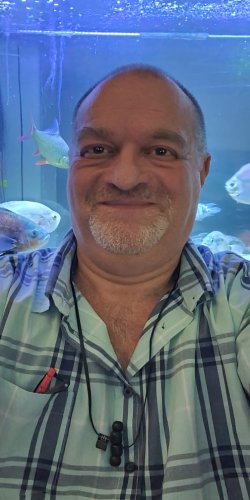
Veteran fish keeper and keen hobbyist with a serious case of MTS. My midlife crisis was the establishment of a fish room, much to my wife’s horror. Little does she know it could be worse!!


